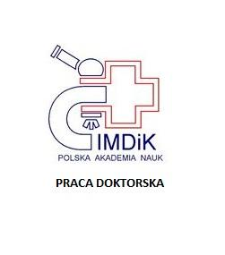
Obiekt
Tytuł: Badanie mechanizmów ekscytotoksyczności w ostym toksycznym działaniu tetrabromobisfenolu A na komórki ziarniste móżdżku szczura w hodowli pierwotnej
Współtwórca:
Ziemińska, Elżbieta (Promotor)
Wydawca:
Instytut Medycyny Doswiadczalnej i Klinicznej im. Miroslawa Mossakowskiego PAN
Miejsce wydania:
Opis:
Bibliogr. na str. 132-158 ; 158s.: tabl., wykr., fotogr. ; 30cm
Uzyskany tytuł:
Stopień studiów:
Dyscyplina :
Abstrakt:
Tetrabrombishenol A (TBBPA) is a brominated flame retardant commonoly used in industry for the manufacture of electrical appliances, textiles, furniture, vehicle and aircraft equipment, as well as in construction materials. Despite assurances that TBBPA is persistent and therefore safe, it has been shown to be present in the environment as well as in human and animal tissue and body fluids samples. Hydrophobic and high lipophilic properties of TBBPA makes is easier to cross membranes and biological barriers (placental and blood-brain barrier) and to penetrate organs and cells. Exposure to TBBPA may occur by inhalation, through dust or contaminated water and food. The study showed TBBPA-dependent phenomena: increase in [Ca2+]i, induction of oxidative stress, which was indicated by an increase in reactive oxygen species (ROS) production, decrease in GSH content and catalase activity, as well as depolarization of mitochondria in CGC. The inhibition of [Ca2+] growth by administering a combination of NMDAR and rianodine receptor (RyR) antagonists prevented induction of oxidative stress and mitochonrial depolarization induced 10µM TBBPA , whereas these effects induced by 25µM TBBPA were only partially inhibited. These results have for the first time directly demonstred that the increase in [Ca2+]i, mediated by NMDAR and RyR, plays a key and primary role in the pathogenesis of TBBPA-induced oxidative stress by 25µM TBBPA. In futher studies , the demonstration of no effect of TBBPA on the binding of labeled NMDAR ligands to the membrane fraction isolated from the rat brain cortex allowed to reject the working hypothesis suggesting direct interactions of TBBPA with NMDAR. However, subsequent experiments revealed for the first time that TBBPA depolarizes the neurons, moreover, both ionotropic glutamate receptors (NMDAR and AMPAR) and voltage-gated sodium channels are involed in this phenomenon. The latter information gives rise to the hypothesis that the depolarization of CGCs exposed to TBBPA, if it partly a primary phenomenon , may promote the activation of the NMDAR channel by releasing magnesium block. The hypothesis the activation of NMDAR in CGCs exposed to TBBPA could be the result of inhibition of glutamate reuptake, which leads to an increase in its concentration in the extracellular environment, has also been tested. The results presented in this paper, analyzed collectively, indicate a pivotal contribution of excitotoxicity in the mechanisms of neurotoxic effects of TBBPA on CGC in primary culture. The key role in these complex and interacting cellular mechanisms is played by the increase in [Ca2+]i, mediated by NMDAR and RyR, leading to induction of oxidative stress and mitochondrial deenergization. The extracellular element of this mechanisms closing the vicious circle of excitotoxicity is an increase in the concentration of endogenous glutamate, leading to activation of NMDAR and AMPAR.
Czasopismo/Seria/cykl:
Szczegółowy typ zasobu:
Identyfikator zasobu:
Źródło:
IMDiK PAN, call. ZS 402 ; kliknij tutaj, żeby przejść
Język:
Prawa:
Creative Commons Attribution BY 4.0 license
Zasady wykorzystania:
Copyright-protected material. [CC BY 4.0] May be used within the scope specified in Creative Commons Attribution BY 4.0 license, full text available at: ; -
Digitalizacja:
Mossakowski Medical Research Institute PAS
Lokalizacja oryginału:
Library of the Mossakowski Medical Research Institute PAS
Dofinansowane ze środków:
Dostęp:
Kolekcje, do których przypisany jest obiekt:
- Repozytorium Cyfrowe Instytutów Naukowych > Kolekcje Partnerów > Instytut Medycyny Doświadczalnej i Klinicznej PAN > Prace dyplomowe > Prace doktorskie
- Repozytorium Cyfrowe Instytutów Naukowych > Piśmiennictwo > Prace dyplomowe
Data ostatniej modyfikacji:
5 sty 2023
Data dodania obiektu:
6 lis 2020
Liczba pobrań / odtworzeń:
636
Wszystkie dostępne wersje tego obiektu:
https://rcin.org.pl./publication/182071
Wyświetl opis w formacie RDF:
Wyświetl opis w formacie RDFa:
Wyświetl opis w formacie OAI-PMH:
| Nazwa wydania | Data |
|---|---|
| Diamandakis, Dominik | 5 sty 2023 |
Obiekty Podobne
Ji, Benjun
Skowrońska, Katarzyna
Łazarewicz, Jerzy
Łazarewicz, Jerzy W. Salińska, Elżbieta

 INSTYTUT ARCHEOLOGII I ETNOLOGII POLSKIEJ AKADEMII NAUK
INSTYTUT ARCHEOLOGII I ETNOLOGII POLSKIEJ AKADEMII NAUK
 INSTYTUT BADAŃ LITERACKICH POLSKIEJ AKADEMII NAUK
INSTYTUT BADAŃ LITERACKICH POLSKIEJ AKADEMII NAUK
 INSTYTUT BADAWCZY LEŚNICTWA
INSTYTUT BADAWCZY LEŚNICTWA
 INSTYTUT BIOLOGII DOŚWIADCZALNEJ IM. MARCELEGO NENCKIEGO POLSKIEJ AKADEMII NAUK
INSTYTUT BIOLOGII DOŚWIADCZALNEJ IM. MARCELEGO NENCKIEGO POLSKIEJ AKADEMII NAUK
 INSTYTUT BIOLOGII SSAKÓW POLSKIEJ AKADEMII NAUK
INSTYTUT BIOLOGII SSAKÓW POLSKIEJ AKADEMII NAUK
 INSTYTUT CHEMII FIZYCZNEJ PAN
INSTYTUT CHEMII FIZYCZNEJ PAN
 INSTYTUT CHEMII ORGANICZNEJ PAN
INSTYTUT CHEMII ORGANICZNEJ PAN
 INSTYTUT FILOZOFII I SOCJOLOGII PAN
INSTYTUT FILOZOFII I SOCJOLOGII PAN
 INSTYTUT GEOGRAFII I PRZESTRZENNEGO ZAGOSPODAROWANIA PAN
INSTYTUT GEOGRAFII I PRZESTRZENNEGO ZAGOSPODAROWANIA PAN
 INSTYTUT HISTORII im. TADEUSZA MANTEUFFLA POLSKIEJ AKADEMII NAUK
INSTYTUT HISTORII im. TADEUSZA MANTEUFFLA POLSKIEJ AKADEMII NAUK
 INSTYTUT JĘZYKA POLSKIEGO POLSKIEJ AKADEMII NAUK
INSTYTUT JĘZYKA POLSKIEGO POLSKIEJ AKADEMII NAUK
 INSTYTUT MATEMATYCZNY PAN
INSTYTUT MATEMATYCZNY PAN
 INSTYTUT MEDYCYNY DOŚWIADCZALNEJ I KLINICZNEJ IM.MIROSŁAWA MOSSAKOWSKIEGO POLSKIEJ AKADEMII NAUK
INSTYTUT MEDYCYNY DOŚWIADCZALNEJ I KLINICZNEJ IM.MIROSŁAWA MOSSAKOWSKIEGO POLSKIEJ AKADEMII NAUK
 INSTYTUT PODSTAWOWYCH PROBLEMÓW TECHNIKI PAN
INSTYTUT PODSTAWOWYCH PROBLEMÓW TECHNIKI PAN
 INSTYTUT SLAWISTYKI PAN
INSTYTUT SLAWISTYKI PAN
 SIEĆ BADAWCZA ŁUKASIEWICZ - INSTYTUT TECHNOLOGII MATERIAŁÓW ELEKTRONICZNYCH
SIEĆ BADAWCZA ŁUKASIEWICZ - INSTYTUT TECHNOLOGII MATERIAŁÓW ELEKTRONICZNYCH
 MUZEUM I INSTYTUT ZOOLOGII POLSKIEJ AKADEMII NAUK
MUZEUM I INSTYTUT ZOOLOGII POLSKIEJ AKADEMII NAUK
 INSTYTUT BADAŃ SYSTEMOWYCH PAN
INSTYTUT BADAŃ SYSTEMOWYCH PAN
 INSTYTUT BOTANIKI IM. WŁADYSŁAWA SZAFERA POLSKIEJ AKADEMII NAUK
INSTYTUT BOTANIKI IM. WŁADYSŁAWA SZAFERA POLSKIEJ AKADEMII NAUK


































